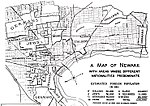Second Reformed Dutch Church
19th-century Reformed Church in America church buildingsChurches completed in 1848Churches in Newark, New JerseyChurches on the National Register of Historic Places in New JerseyNational Register of Historic Places in Newark, New Jersey ... and 3 more
New Jersey Register of Historic PlacesNew Jersey Registered Historic Place stubsNew Jersey church stubs

Second Reformed Dutch Church (also known as Mt. Carmel Roman Catholic Church; Ironbound Educational and Igreja Assembleia de deus) is a historic church building at 178-184 Edison Place in Newark, Essex County, New Jersey, United States. It was built in 1848 originally for a Dutch Reformed congregation. The building added to the National Register of Historic Places in 1979. It has been home to several other congregations since its founding, including Igreja Assembleia de deus, an Assemblies of God congregation led by Pastor Welbr DosSantos.
Excerpt from the Wikipedia article Second Reformed Dutch Church (License: CC BY-SA 3.0, Authors, Images).Second Reformed Dutch Church
Bruen Street, Newark
Geographical coordinates (GPS) Address Nearby Places Show on map
Geographical coordinates (GPS)
| Latitude | Longitude |
|---|---|
| N 40.7325 ° | E -74.164166666667 ° |
Address
Bruen Street
07105 Newark
New Jersey, United States
Open on Google Maps







